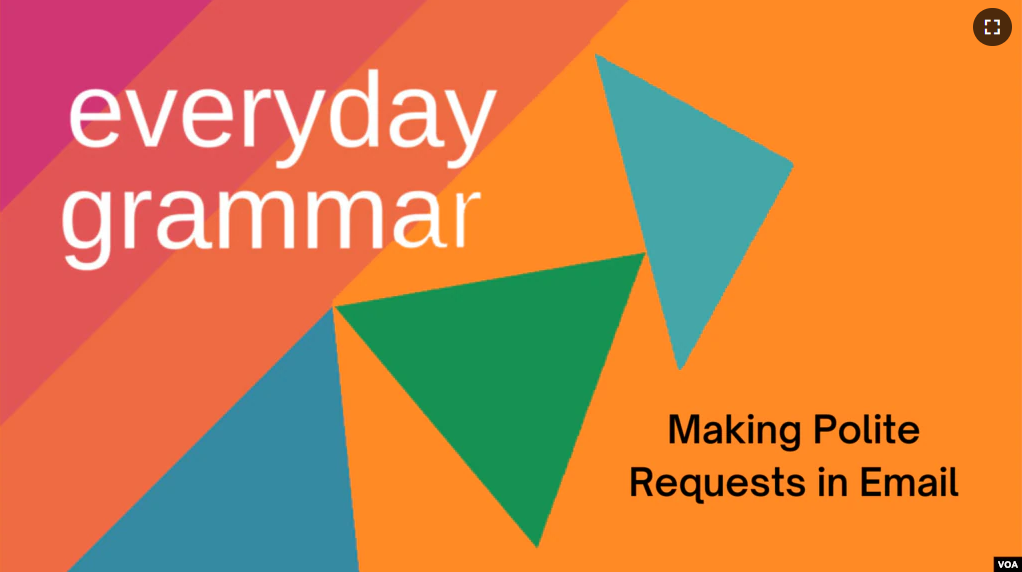Hello. In this week’s Everyday Grammar report, we will talk about how to communicate politely in emails, especially when making requests.
Samuel from China recently wrote to us asking about how to communicate more effectively in email.
Thank you, Samuel for suggesting the idea.
Knowing how to express politeness is important, especially if you are emailing in English for a job or school.
Let’s consider a few ways to make our communication by email more polite when making requests.
Politeness
When writing a request by email, there are several ways to express your politeness.
Turning a command into a question
Instead of making your request as a command, turn the request into a question. Commands or imperatives use the “you” form of a verb to create the command.
Instead of:
Please meet me at 5 PM.
You could say:
Do you want to meet me at 5 PM?
Here we use a yes or no question to make the request.
You can make a yes or no question this way:
Auxiliary Verb + Subject + Main Verb
The question permits the receiver a choice which is more polite. The receiver could say “yes” or “no” and provide a reason or suggest a different time to meet.
Use of please
Did you notice anything about the use of “please” in the above examples?
The word “please” was used in the command. And it was not used in the more polite question.
We do not always have to use please to make a polite request. Sometimes the use of “please” can come across as too strong or demanding. In email, we do not always pick up on the tone of what is written.
Could you please meet me at 5 PM?
This question may come across as too strong.
Would you like to meet me at 5 PM?
Using “would like” is a polite way to offer and make requests. The use of “please” is not necessary here.
Requests with modals
Modals are verbs that are used to express possibility, ability, or necessity. These include verbs like would, could, will, and can, among others.
You can use modals with your question to make a request. “Could” and “Would” are the more polite forms. “Can” and “will” are still polite, but they are used for requests that are more casual or informal.
Here are some common expressions with modals to make your request:
Could
Could you help me with this?
Do you think you could meet me later next week?
Would
Would you have time to help me?
Would you be able to take me to the store later?
Will
Will you still pick me up from the airport?
Can
Can you get me a coffee if you’re going to the café?
When we use these modals to make requests, the level of politeness is understood because the polite meaning is attached to the modal itself.
Closing thoughts
Today, we talked about three ways to make our requests more polite. We can turn a command statement into a question. We can choose to use or not use “please” when making the request. And we can use modals to help express the request.
Next time we will continue our report about politeness in emails, covering three more ways to make polite requests.
Now it is your turn! Practice politely requesting something using the three ways discussed above. For example, you could request a favorite language or grammar subject for us to explore. Let us know in the comments below or write to us at learningenglish@voanews.com. We might use your message in a future episode of Everyday Grammar!
I’m Faith Pirlo.
And I’m Jill Robbins.
Faith Pirlo wrote this report for VOA Learning English.
_______________________________________________________________
Words in This Story
politely – adv. to do something showing good behavior and respect for other people
formal – adj. following established form, custom, or rule
tone – n. a quality, feeling, or attitude expressed by the words that someone uses in speaking or writing
casual – adj. not formal; done without much thought or effort
informal – adj. not requiring serious or formal behavior or dress : suitable for ordinary or everyday use with close friends and family
_________________________________________________________________
Do you have a question for the teacher? We want to hear from you. We have a new comment system. Here is how it works:
- Write your comment in the box.
- Under the box, you can see four images for social media accounts. They are for Disqus, Facebook, Twitter and Google.
- Click on one image and a box appears. Enter the login for your social media account. Or you may create one on the Disqus system. It is the blue circle with “D” on it. It is free.
Each time you return to comment on the Learning English site, you can use your account and see your comments and replies to them. Our comment policy is here.
